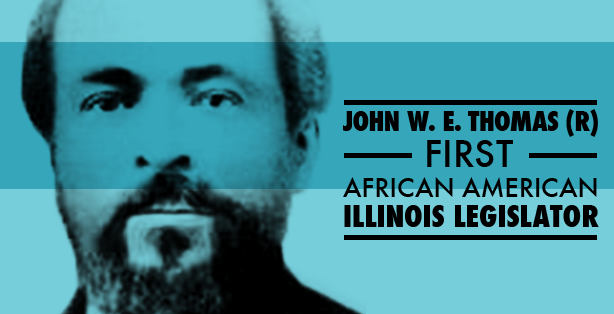Amid the glitz and celebration of America’s centennial year, November 7, 1876, was truly a date for the history books. That day saw a razor-thin Presidential election that was not resolved until the following March, it saw a ham-handed attempt to steal the body of Abraham Lincoln from his Springfield tomb, and it was the day that voters in the 2nd District elected Rep. John W.E. Thomas (R-Chicago) as Illinois’ first African-American state legislator.
Thomas’ path to the General Assembly began eleven years earlier when Governor Richard Oglesby signed legislation repealing Illinois’ discriminatory “Black Laws,” a series of statutes which prevented African-Americans from voting, serving on juries or entering into contracts. In the years after the Civil War, barriers to African-American participation in Illinois politics fell like dominoes: repeal of the Black Laws in 1865, full suffrage for African-American males in 1870, defeat of proposed restrictions on voting rights for African-Americans at the 1870 Constitutional convention. The post-war march of civil rights then led directly to a seat in the state House with John W. E. Thomas’ election in 1876.
Thomas was born into slavery in Alabama in 1847. He became a teacher, then married and moved to Chicago just after the war, opening a grocery on what is now Federal Street. Teaching remained his passion, though, and it wasn’t long before he had opened a school in his home, Chicago’s first such school for African-Americans. “The child and the gray-haired freedman, side by side, learned their letters in his home,” the Chicago Inter-Ocean newspaper was to write later.
In 1874, Thomas entered politics by becoming a delegate to the Republican county convention. Thomas became active in the Second Ward Republican Club, and soon saw his name along with several others placed in nomination at the Republican nominating convention for Representative from the 2nd district in the 1876 election. Under the cumulative voting system established by the 1870 Constitution, three members were elected from each district. Republicans nominated incumbent Rep. Solomon Hopkins (R-Lake) and Thomas for their slate.
Thomas launched a whirlwind campaign, speaking in the different wards and communities which made up the district, while the city’s newspapers and political factions clashed over his qualifications for office. On election night, Thomas garnered 11,532 votes, enough to elect him to one of the 2nd district’s three seats. Two years later, Thomas wrote in the Chicago Evening Journal that, “the majority which I received on election day demonstrated at the polls that the people approved my nomination. Without egotism, I may be permitted to say that it was a proud day for me and for the colored people of the great Republican State of Illinois, when, for the first time, and that in the Centennial year, a colored man took his seat in the Legislature of that state which gave to the world the emancipator of my race, the martyred Lincoln.”
Rep. Thomas served a single term in the House, then launched a comeback bid and was elected again in 1882. He served two more terms, including a stint on the Judiciary Committee, during which time the General Assembly passed civil rights legislation banning discrimination in public places. He went on to serve as a Republican presidential elector in 1892, and practiced law in Chicago until his death in 1899 at the age of 54.
The electoral progress of African-Americans in Illinois grew and expanded in the years after John W. E. Thomas’ history-making election. Thomas’ legacy would live on in greater African-American participation in politics in Chicago and throughout Illinois, including the 1983 election of Harold Washington as the first African-American mayor of Chicago. Today, both Rep. Thomas’ and Mayor Washington’s final resting places can be found in Oak Woods Cemetery on Chicago’s South Side.
